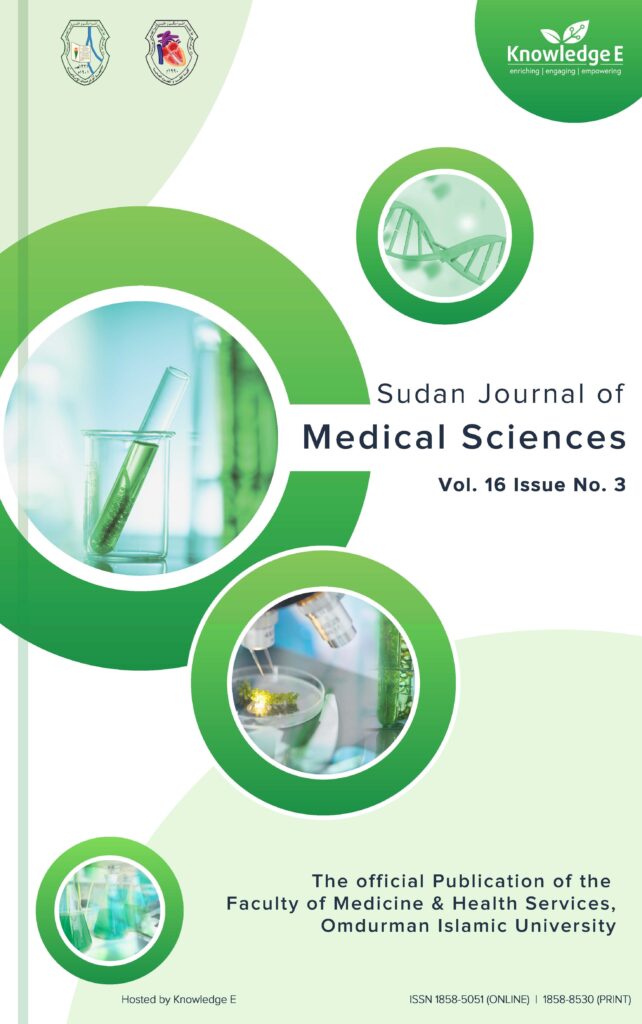
Sudan Journal of Medical Sciences
ISSN: 1858-5051
High-impact research on the latest developments in medicine and healthcare across MENA and Africa
Enhancing the Knowledge of Cervical Cancer Screening among Female Nursing Students: An Interventional Educational Program
Published date: Dec 31 2020
Journal Title: Sudan Journal of Medical Sciences
Issue title: Sudan JMS: Volume 15 (2020), Issue No. 4
Pages: 431 - 439
Authors:
Abstract:
Background: Cervical cancer is a growing health risk facing women worldwide with the human papillomavirus (HPV) as the primary underlying cause. Pap smear is a simple screening test that can detect early changes in cervical cells, which might develop into cancer cells. Raising awareness of cervical cancer prevention has a significant impact on decreasing the burden of the disease. The aim of the study is to assess female nursing students' knowledge on early detection and screening of cervical cancer, and to determine the effectiveness of an educational program. Methods: A quasi-experimental research design (one group for pre- and post-tests) was utilized with a convenience sample of 130 female nursing students in one of the nursing colleges in Saudi Arabia. The study’s educational intervention included information about anatomy of genital tract and the importance of regular check-ups. The pre- and post-tests were applied to identify changes after intervention measures. Results: The mean age of the participants were 21.32 years (SD: 1.34). The findings revealed a significant improvement of post-test students’ knowledge in all items related to risk factors, signs and symptoms, occurrence, identification of HPV as causative agent, vaccination against HPV, and finally Pap smear for early detection and screening of cervical cancer. Conclusion: The study results support implementing educational intervention to improve nursing students' knowledge and awareness about cervical cancer prevention. Furthermore, it is imperative that cervical cancer awareness education modules should be developed and integrated within the nursing curriculum. Further studies with large sample size are recommended to increase generalization of the results.
Key words: cervical cancer, education program, primary prevention, nursing students, Saudi Arabia
References:
WHO. (2020). WHO Technical Guidance and Specifications of Medical Devices for Screening and Treatment of Precancerous Lesions in the Prevention of Cervical Cancer 2020. Geneva, Switzerland: WHO.
[2] Marek, E., Dergez, T., Rebek-Nagy, G., et al. (2012). Effect of an educational intervention on Hungarian adolescents’ awareness, beliefs and attitudes on the prevention of cervical cancer. Vaccine, vol. 30, no. 48, pp. 6824–6832.
[3] Ahmed, S. R. H., Esa, A. S. M., and Mohamed El-zayat, O. S. (2018). Health Belief Model-based educational program about cervical cancer prevention on women knowledge and beliefs. Egyptian Nursing Journal, vol. 15, no. 1, pp. 39–49.
[4] Ombech, E. A., Muigai, A., and Wanzala, P. (2012). Awareness of cervical cancer risk factors and practice of Pap smear testing among female primary school teachers in Kasarani division, Nairobi Kenya. African Journal of Health Sciences, vol. 21, no. 21, pp. 121–132.
[5] Pimple, S. A. and Mishra, G. A. (2019). Global strategies for cervical cancer prevention and screening. Minerva Ginecologica, vol. 71, no. 4, pp. 313–320.
[6] HPV Information Centre. (2019). Saudi Arabia Human Papillomavirus and Related Diseases Report. HPV Information Centre.
[7] Alsbeih, G. (2014). HPV infection in cervical and other cancers in Saudi Arabia: implication for prevention and vaccination. Frontiers in Oncology, vol. 4, p. 65.
[8] WHO. (2012). Health Education: Theoretical Concepts, Effective Strategies and Core Competencies—A Foundation Document T Guide Capacity Development of Health Educators. Geneva: WHO.
[9] Mary, B. and D’Sa, J. L. (2014). Evaluation of an educational program on cervical cancer for rural women in Mangalore, Southern India. Asian Pacific Journal of Cancer Prevention, vol. 15, no. 16, pp. 6603–6608.
[10] Naik, P. R., Nagaraj, K., and Nirgude, A. S. (2012). Awareness of cervical cancer and effectiveness of educational intervention programme among nursing students in a rural area of Andhra Pradesh. Healthline, vol. 3, pp. 41–45.
[11] Naz, M. S. G., Kariman, N., Ebadi, A., et al. (2018). Educational interventions for cervical cancer screening behavior of women: a systematic review. Asian Pacific Journal of Cancer Prevention, vol. 19, no. 4, pp. 875–884.
[12] Siddiqui, A. F., Al Qahtani, S. Q., Al Qahtani, A. M., et al. (2018). Knowledge, attitudes and practice of burns prevention and first aid among medical students of King Khalid University, Saudi Arabia. Bangladesh Journal of Medical Science, vol. 17, no. 4, pp. 537–544.
[13] Abo-Lela, H., Mansour, S. E., Rafik Ibrahem Barakat, R. I., et al. (2017). Effect of applying educational sessions on the nurses’ knowledge regarding cervical cancer. IOSR Journal of Nursing and Health Science, vol. 6, pp. 29–36.
[14] Pirzadeh, A. and Mazaheri, M. A. (2012). The effect of education on women’s practice based on the health belief model about pap smear test. International Journal of Preventive Medicine, vol. 3, no. 8, pp. 585–590.
[15] Atwa, A. M. E., Hassan, H. E., and Ahmed, S. I. (2019). The impact of a hospital-based awareness program on the knowledge of patients about breast cancer and cancer cervix. International Journal of Nursing Studies, vol. 4, no. 1, p. 20.
[16] Tsikouras, P., Zervoudis, S., Manav, B., et al. (2016). Cervical cancer: screening, diagnosis and staging. Journal of the Balkan Union of Oncology, vol. 21, no. 2, pp. 320–325.
[17] Kessler, T. A. (2017). Cervical cancer: prevention and early detection. Seminars in Oncology Nursing, vol. 33, no. 2, pp. 172–83.
[18] Devi, A. M. (2019). To assess the effectiveness of Planned Teaching Program (PTP) on knowledge regarding early detection and prevention of cervical cancer among women: pre-experimental study. International Journal of Nursing Education, vol. 11, no. 2, pp. 1–6.